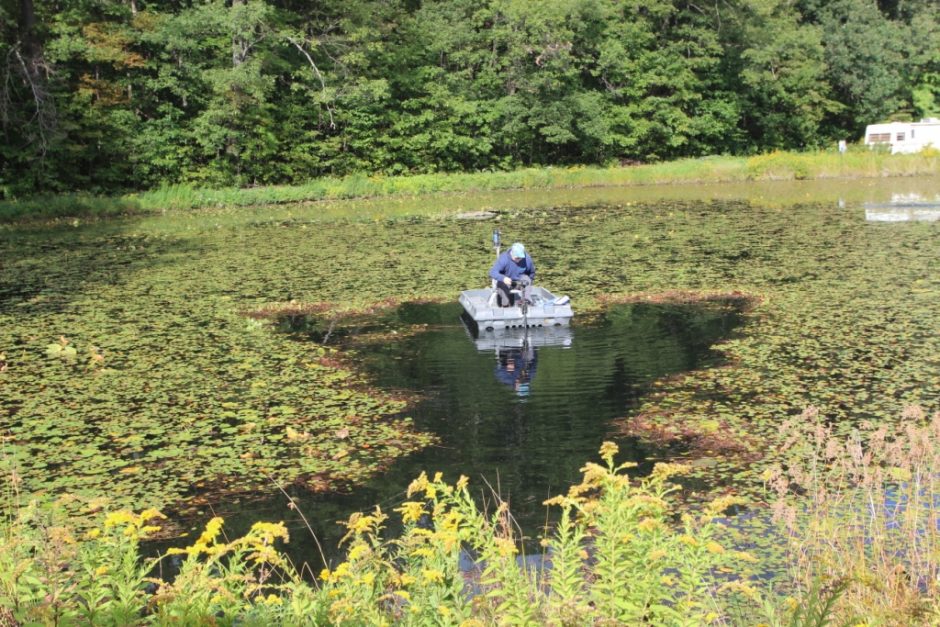Aquatic plants are not necessarily considered a weed or a nuisance to the pond environment. They provide various benefits to the animals in it in several ways. They can be food to the fish, source of oxygen to the water, a place of refuge for so many little fish who are hunted by their predators, and at times a habitat for nesting or spawning organisms. Some are even added to the pond for aesthetic purposes, such as the water lily and other aquatic wildflowers. When these aquatic plants cover more than 25% of the entire pond surface area, they fall under the category “dense growth” or overgrowth, and they can be a severe problem to pond owners. Knowing how to control pond weeds, then, becomes crucial.
Problems Due to Pond Weed Overgrowth
Why do pond weeds that may be beneficial in moderate numbers become a problem when they grow in excess? There are numerous harmful effects to pond weed overgrowth that make them a source of headaches for many pond owners.
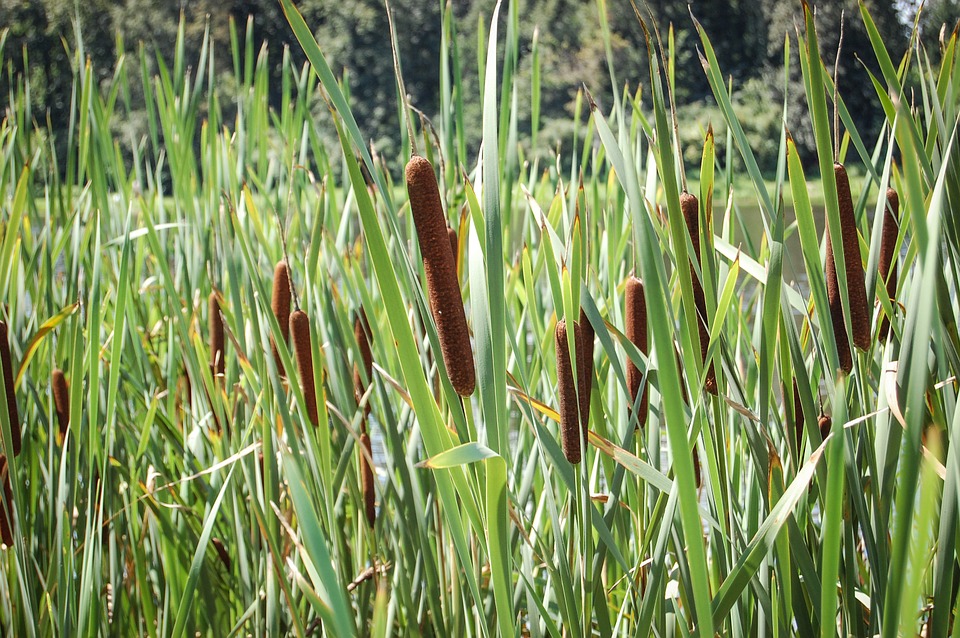
Too Much Cover
When aquatic plants occupy substantial space in your lake, whether on the surface of the pond or submerged underwater, they can hinder predation as they give cover to preyed upon fish. This situation may be useful from the perspective of the tiny fish in the pond, but unfortunately, they result in stunted growth for the sportfish populations since they cannot gain access to their food.
Suffocation
When water weeds grow too densely, nutrients in the pond are depleted, and some die and sink to the bottom of the lake to decompose. Besides nutrients, oxygen supply will also run short due to this process and result in fish deaths due to suffocation. Green plants mostly generate oxygen in the daytime when the sun is up and consume at night, but due to excessive growth of pond weed, there won’t be enough either for them or for the fish population.
Water Quality
Pond algae can also cause the pond water to turn into a nasty color and to emit an unpleasant scent like the smell of a rotten egg. This scenario happens when overgrowth dies and decays, and it brings down the overall quality of the water in your pond.
Restriction
When there is too much vegetation in the pond, activities are restricted in the water not just for aquatic animals but also for people who want to fish, go boating, swim, or do water sports. It’s not just the life of the pond animals which are hindered and threatened but also the lives of people who want to enjoy the pond.
To cite specific examples of how certain weeds negatively affect pond life, we can take a look at cattails. This plant can sprout root-like protrusions that form rhizome mats on the pond bottom. They can spread out quite extensively, and even if you try and cut them off at certain parts, if they have established deeply in the pond, they will continue growing without hindrance until they choke off all other plant and animal life in the water.
Another example is pond algae. Though they sit at the bottom of the food chain and provide food to numerous pond fish, they can be a problem when they overpopulate the pond. Pond algae can also cause the issues mentioned above, and some particular examples will include the reed grass, or phragmites, which can be as invasive as the cattails with their similar rhizome mats. Another example is the cyanobacteria, known as the “bad” algae. It is not real algae but acts like one as it exhausts nutrients from the pond.
These are but a few of the cases that show us why we need to learn how to control pond weeds. Otherwise, they will continue to choke out life in their environment and may cause the collapse of pond ecosystems that can cascade to other bodies of water such as rivers and lakes.
Dealing with Pond Weeds
There is no blanket solution to dealing with different types of pond weeds. To effectively prevent them from reaching uncontrollable levels and overtaking the pond, you have to know how to control pond weeds with the different kinds that you have and craft strategies and techniques to eradicate them or, at the very least, reduce them to manageable levels.
How to Control Pond Weeds – Submerged
This type of weeds is what you can find mostly underwater, but some parts of the plant are floating on the surface as well. They are very soft and limp, making them easy to manually remove from the pond through cutting, raking, or a pond vacuum.
Submerged weed varieties are the Eurasian watermilfoil, hydrilla, bladderwort, pondweed, and coontail. Others belong to this category, but these are the most common and problematic ones.
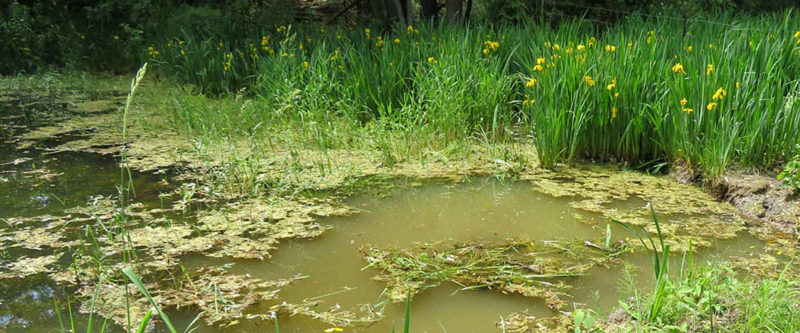
Herbicides
When submerged weeds pose such a severe threat to your pond ecosystem due to their excessive growth, you can utilize herbicides only as a last option. There are various treatments you can choose from, which are available in the market, but you have to be aware of certain restrictions and regulations using weed killers. Also, read the label carefully and follow the instructions to the letter because different formulations require specific methods of application.
A particular brand, Sonar, is one of those types that you can use once to treat the infestation, and it will kill all the floating and submerged weeds in your entire pond for a whole season. The downside to this is that for several months, your pond is exposed to the herbicide since the chemicals persist in the water to eradicate the problematic weeds.
The contact herbicide Ultra Pondweed Defense is also an excellent option and is a broad formulation that will kill several types of weeds at once.
Pond Dyes
A pond dye will also help eliminate submerged weeds in your pond by covering the surface of the water and blocking out sunlight. Without the sun, the existing plants will eventually die off, while those who persist will be prevented from further regrowth. The Eurasian milfoil mentioned above is a rather aggressive species and can reproduce even if a tiny part remains of the plant, so when removing this particular weed from the pond, the method must be extensive and thorough in driving them away entirely.
Manual Methods
Because submerged weeds are soft plants, they can be easily removed manually using rake, skimmer, or pulling by hand or cutting them directly as you access them. Another method is to plant trees around the perimeter of the pond to provide shade to parts of the lake where the submerged weeds are. This step will deter their growth due to a lack of sunlight. You have to carefully plan where to plant these trees such that other plants in the pond will not be affected.
How to Control Pond Weeds – Floating
The floating weeds are those which can be found in the shallow parts of the pond, just several meters from the surface. But they can also dwell in deeper regions. Because they are floating on the surface of the lake, these weeds can completely block out the sunlight. It also affects oxygen from ever reaching a considerable percentage of the pond, which is from the surface down.
Floating weeds are waterweed, spatterdock, water hyacinth, water lettuce, duckweed, water lilies. These are a lot less of a challenge to control because, unlike the submerged weeds, they do not have the rhizome mats and are not as widespread in their manner of overgrowth. These weeds are also more reactive to chemical and manual methods of elimination.
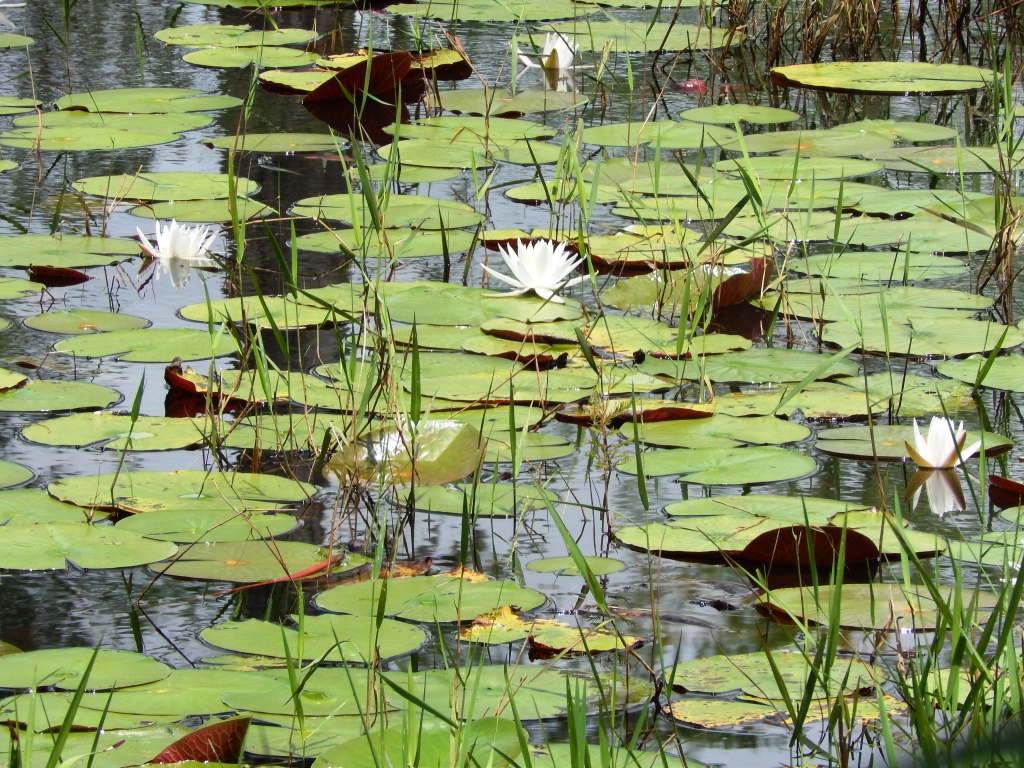
Herbicides
Use herbicides only when the floating weeds have already established their presence in the pond. And all other methods to eradicate them will prove to be futile or insufficient in themselves. Some systemic or contact herbicides like the Ultra PondWeed Defense are potent in fighting all types of weeds, including floating, submerged, and even emergent types. The good thing about this herbicide is that it doesn’t stay in the water as it does its job. It breaks down after working to eliminate its targets, posing less risk to the animals and plants in the pond.
Manual Methods
Floating weeds can be removed manually through conventional means such as raking, pulling, and skimming. Some of them do have the rhizome mats, which can be tough to deal with, but they cannot resist the herbicides if you use them in tandem with these manual methods. Other floating weeds that can be easily pulled are water lettuce and duckweed. The latter may need to be skimmed or vacuumed since they are quite small.
Most pond weeds prefer stagnant waters where there is least aeration, so providing water movement to your pond will discourage the growth of these floating weeds.
How to Control Pond Weeds – Emergent
These weeds thrive in a few inches of water. So it’s hard to categorize them as a terrestrial plant or an aquatic one. They are partly submerged and partly exposed. These are the purple loosestrife, phragmites and cattail species, alligator weed, and bulrush.
These plants live on the shorelines, riverbanks and lake embankments. They can spread rapidly over great distances. They make access to bodies of water and other areas restricted for both people and animals.
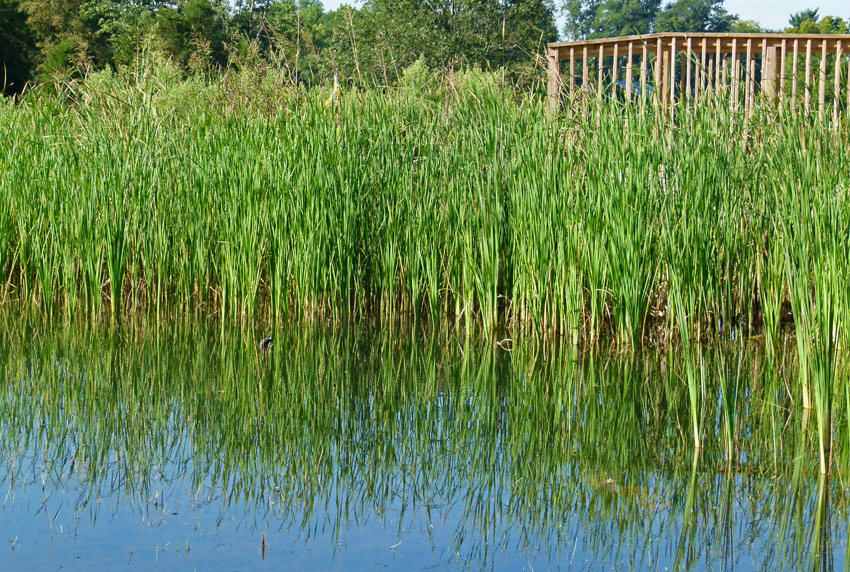
Herbicides
There are certain cases when the use of herbicides is called for and extremely necessary. Some emergent weeds expose fish and other organisms to such massive threat that the use of these chemicals become the most excellent option. The systemic herbicide formulated for emergent weeds such as the bulrush, phragmites, and the cattails is applied directly to these plants. It breaks down and kills them, including the entire plant structure with the extensive rhizome network. The targeted treatment will ensure that only the emergent weeds are eradicated. And other plants and animals in the pond are safe from the harmful effects of the herbicide.
A suitable emergent herbicide is glyphosate, which is a reasonably priced type but powerful and effective. However, in certain places, you will be required to obtain a weed killer’s permit. Or hire a professional to implement the treatment to your pond. This step is to avoid mistakes in application since this is one of the most potent herbicides in the market. And your blunders may prove disastrous for your pond.
Pulling and Cutting
When you cut or pull emergent weeds, often, their rhizomes remain in the water. They reproduce more plants to replace the ones that were lost. To ensure they will not come back and overpopulate your pond again. You have to employ these manual methods. And make sure that their root-like extensions are included in your removal. Some weeds are so deeply entrenched into their location. It’s difficult to just pull them without the help of some herbicides to make the task a lot easier.
Schedule a convenient time of pulling and cutting before the hot summer months. Since, during this season, they grow at rapid rates and re-sprout. Despite the effort of you trying to remove them from time to time. You can decide to take them away come September. When they have exhausted most of their energy in their reproduction spree in the summer. This strategy must be done every so often until these emergent weeds grow less and less after a few years.
Keep in mind that when you dispose of these weeds after cutting, be extra careful not to spread their seeds. Or else you will have to deal with new ones. Also, accept the fact that some of their seeds will remain in your seed bank. So that your fight against these emergent weeds will likely be part of your life as a pond owner.
How to Control Pond Weeds – Algae
Like most of the pond weeds, algae also have benefits to ponds in moderate amounts. It has a role in the overall functioning of the pond ecosystem. Only when its reproduction spirals out of control when it becomes a problem for pond owners. If you regularly monitor your pond water quality, it will help you know if the levels of phosphates and nitrates. If they are within healthy parameters, even in the presence of moderate amounts of algae.
The string or filamentous algae and the planktonic type are highly beneficial to the organisms in your pond. They are a source of food. And, also oxygen and the primary producers for the fish, insects, and waterfowl in the lake.
Other types of algae that may be present in a lagoon are the diatoms, Euglenophyta, red algae (Rhodophyta), brown algae (Phaeophyta), golden algae (Chrysophyta), green algae (Chlorophyta), blue-green algae (cyanobacteria), and dinoflagellate.

Herbicides
Some herbicides are suitably effective for pond algae, such as cutrine plus or copper sulfate. Don’t forget to read the specific instructions for the application since there are dosage variations for every product treatment. You can start using the herbicide on 50% of the surface area of your pond. And then proceed to do the other half when you’re done. The goal is to remove the algae as soon as they die.
Alternatively, there are beneficial bacteria or natural microbes that you can add to the pond to induce the cellular breakdown of the algae. Minus the threat to other living organisms in the water that some herbicides pose. It is still essential to get rid of the dead algae as soon as you’re done with the treatment. To avoid them sinking to the pond bottom and using up a huge amount of oxygen as they decompose.
Water Drain
This method is considered only as a last resort since it is costly in terms of time and money. And disrupts the maturity and normal functioning of the lake ecology. When you empty the water in your pond, all the nutrients go down the drain with it. However, you can discharge the water to your garden where your plants and trees will benefit from the pond nutrition.
When all other strategies fail, you can empty your pond and remove all the algae in it. Then you can give your lagoon a proper washing and scrubbing and refill it with fresh and clean water again. This method is also an excellent way to make sure that even the algae’s spores are eliminated. You can then install a UV clarifier to keep the water bright and clean for a long time.
Manual Methods
Raking and pulling of algae are particularly useful, especially for string algae that clump and intertwine in mats. You can use a good rake or even your bare hands to get them out of the lake. As they are not large or heavy.
Pond Dyes
The objective of using pond dyes is to provide a covering from the sun for the plants in the water, including the algae. This action will cause them to die from sunlight deprivation eventually. However, the dye doesn’t distinguish between algae and useful plants in your pond. So even the ones you want to keep will also be harmed by the lack of sunlight.
UV Clarifier
Mechanical clarifiers may also be employed, which are useful for small and medium-sized ponds but not for large lakes. Floating and submerged algae freely moving in the lake will be captured and filtered by this equipment. The UV clarifier will not pose harm to any microorganisms, fish, or wildlife in your pond. Therefore, making it an excellent option as a pond weed management tool.
Final Words
To learn how to control pond weeds will require you to consider the specific types that you are dealing with, the size of your lake, and its location. So you can come up with the perfectly suitable control method that will be most effective for the management of these aquatic plants.
